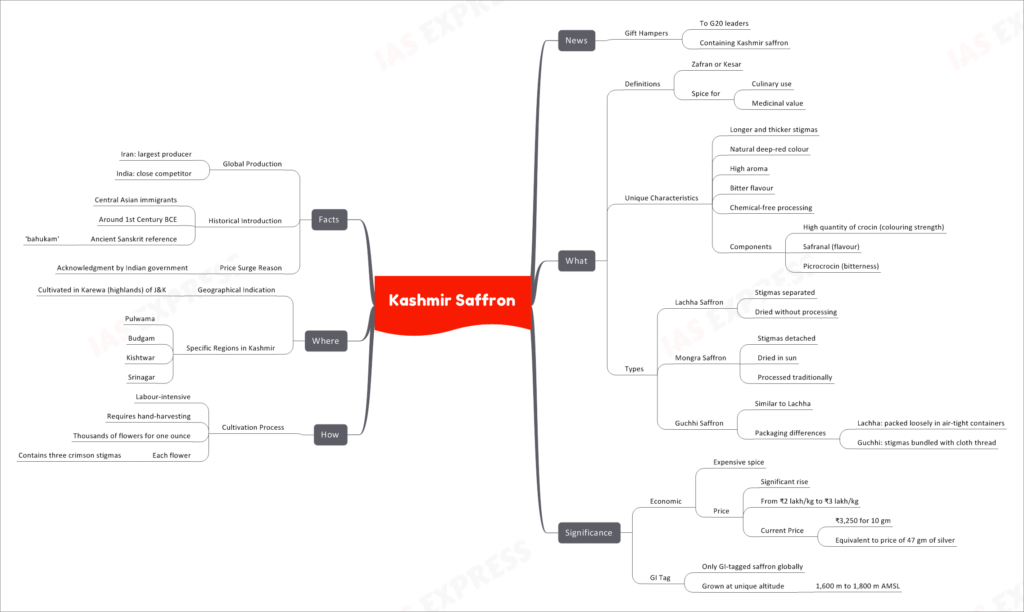Kashmir Saffron

In a remarkable gesture, India has presented gift hampers to the leaders of the G20 nations, containing the world-renowned Kashmir saffron. This highly sought-after spice, known as “Zafran” or “Kesar,” possesses unique characteristics and a rich history that make it a valuable offering.
This topic of “Kashmir Saffron” is important from the perspective of the UPSC IAS Examination, which falls under General Studies Portion.
Definitions and Unique Characteristics
Zafran or Kesar
Kashmir saffron, locally referred to as “Zafran” or “Kesar,” is a spice celebrated for its culinary uses and medicinal value. It stands out due to its extraordinary characteristics:
- Longer and thicker stigmas
- Natural deep-red color
- High aroma
- Bitter flavor
- Chemical-free processing
- Rich in components like crocin (coloring strength), safranal (flavor), and picrocrocin (bitterness).
Types of Kashmir Saffron
- Lachha Saffron: In this variety, stigmas are separated and dried without processing.
- Mongra Saffron: Stigmas are detached and dried in the sun, following traditional methods.
- Guchhi Saffron: Similar to Lachha, but with packaging differences – stigmas are bundled with cloth thread, whereas Lachha is packed loosely in air-tight containers.
Significance
Economic Value
Kashmir saffron is considered one of the world’s most expensive spices, with prices soaring from ₹2 lakh/kg to ₹3 lakh/kg. Currently, it is valued at ₹3,250 for 10 gm, equivalent to the price of 47 gm of silver.
Geographical Indication (GI) Tag
Kashmir saffron holds the distinction of being the only GI-tagged saffron globally. Its cultivation at altitudes ranging from 1,600 m to 1,800 m above mean sea level (AMSL) in the Karewa highlands of Jammu and Kashmir contributes to its unique qualities.
How and Where
Cultivation Process
The cultivation of Kashmir saffron is labor-intensive and requires meticulous hand-harvesting. Thousands of saffron flowers are needed to produce just one ounce of saffron, with each flower containing three crimson stigmas.
Geographical Origin
Kashmir saffron is primarily cultivated in specific regions of Kashmir, including Pulwama, Budgam, Kishtwar, and Srinagar, all of which contribute to the spice’s distinct flavor and aroma.
Facts
Global Production
While Iran is the largest producer of saffron globally, India is a close competitor, with Kashmir saffron being highly sought after for its quality.
Historical Introduction
The history of saffron in Kashmir dates back to around the 1st Century BCE when Central Asian immigrants introduced its cultivation. Ancient Sanskrit references even mention saffron as “bahukam.”
Price Surge Reason
The acknowledgment of Kashmir saffron by the Indian government and its subsequent presentation as a diplomatic gift to G20 leaders has contributed to the recent surge in its price, highlighting its value on the global stage.

